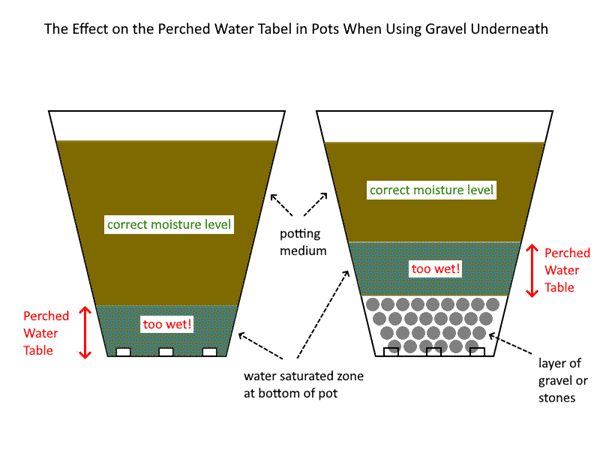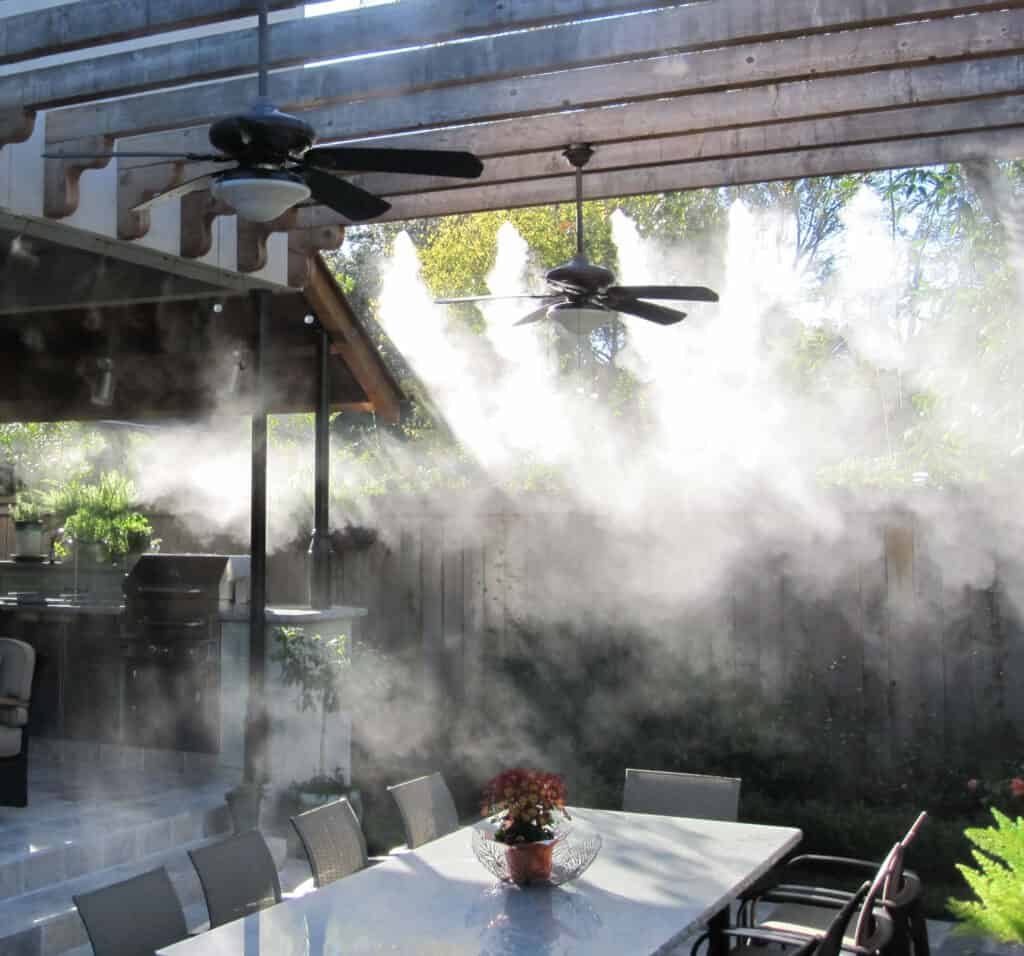To begin with, I do not turn the air in my dry desert home into tropical or sub-tropical using these methods.
While there is not a measurable increase in humidity overall..
..they do seem to work to add more moisture to the air for short periods of time.
HOUSEPLANTS NEED HOW MUCH HUMIDITIES?

I have read that tropical and subtropical houseplants prefer a humidity between 50 – 60%.
Tucson is very dry, with a humidity around 28%.
The humidity didn’t go above 10% on many days last summer.
That’s dry!
Apparently humans thrive in a humidity of around 50%.
Your plants may not require any of these methods if they are looking fine.
The telltale sign of indoor plants needing more humidity is dried leaves; dried edges; and/or dry tips.
METHODS FOR INCREASING HUMIDITY FOR PLANTS

Humidifier/Diffuser
It seems to be these that appear to help the most with plant humidity since they cover a larger area.
All of mine are relatively small and cover an area of approximately 200-300 square feet.
They’re located in my dining and living rooms, kitchen, and master bedroom.
It’s on for about six hours about five days a week, and in the bedroom, it’s on at night.
In general, 6-8 hours a day..
..4-5 days a week should be ok depending on how big the room is and the relative humidity.
There is a potential problem with humidifiers if you don’t clean them correctly on a regular basis.
If you do that, you will have mold and bacteria growing on the humidifier.
You can also overdo it as well.
A couple of the humidifier models I have have been discontinued.
Here is a model similar to the one in my dining room and the one in my bedroom.
My two new humidifiers have been back ordered from Canopy.
This is a relatively new brand (which is in high demand at the moment!)..
..that appeals to me because they put out hydrated air instead of mist.
Apparently, there are a lot fewer potentially harmful particles in the air.
It’s also much easier to clean them and there’s a filter to change, which is good.
Group your indoor plants together
The plants release moisture when they transpire..
..so it stands to reason putting several together would help.
In my opinion, grouping them on the floor, on tables, and on plant stands, along with a humidifier..
..is the best option.
Water in saucers filled with gravel, pebbles, and glass chips
These are sometimes called “mini humidity trays”.
I keep the water level just above the rocks to avoid root rot.

The bowls will be filled with water
On the long table filled with plants I keep 3 small bowls filled with water.
Like the previously mentioned method..
..this only benefits the plant or plants nearby.
Misting
Every few weeks I mist the air around my plants.
Make sure the foliage doesn’t stay too wet, especially at night.
Also, you don’t want the soil to be consistently wet either since it could cause mold to grow on the surface.
My air plants get misted a few times a week and soaked once a week.

Take your plants to the kitchen sink or shower.
To give my smaller plants a nice spraying every 2-3 weeks..
I take them to the kitchen sink and my medium-sized plants to the shower.
They hang out there for an hour or two to enjoy all the moisture.
Keeping them clean also helps!
Plants can be placed close to a sink in the kitchen or bathroom.
Make sure the bathroom is one that you frequently visit.
I hang my air plants next to the sink in the kitchen/family room.
PLANT HUMIDITY FAQS
Does misting help with humidity?
You must mist the air all around the plants and not just the foliage with this temporary fix.
Floppy-leaved plants do not like being sprayed, just as succulents and cacti do not require spraying.
Are humidifiers good for indoor plants?
Certainly.
This is what seems to work best when it comes to controlling plant humidity.
You can overdo it though since most are subject to mold and bacterial growth if not cleaned on a regular basis.
Does a bowl of water help humidify a room?
The aeration should be applied around the plant only, not the entire room.
Do humidity trays work?
They boost moisture just a bit right around the tray.
Many people use them for Orchids and African Violets.
Do all plants like humidity?
No, all plants do not need humidity.
Most succulents and cacti native to desert areas prefer low levels of humidity.
Does spraying water on plants help?
It may not help plants with humidity levels, but it sure must feel good.
Plants breathe through their pores, so spraying them also keeps them clean, which makes respiration easier.
What humidity do houseplants need?
According to my research, a humidity level between 50-60% is ideal for tropical & sub-tropical plants.
LOW HUMIDITY HOUSEPLANTS
I wanted to include some indoor plants that I’ve found to be the most dry air tolerant (meaning these show no signs of stress):
- Cacti
- Fleshy succulents including Aloe Vera, Kalanchoes, Calandivas, String of Pearls, String of Bananas, Jade Plant, Pencil Cactus, and Snake Plants, Rubber Plant, ZZ Plant, Hoyas, Pothos, and thick-stemmed Peperomias like the Baby Rubber Plant.

FAQ About Repotting Plants
Can you kill a plant by repotting?
Under most circumstances no.
The only exceptions would be if the roots are severely damaged during the process, or it is drowned or overwatered after planting.
What happens if I don’t repot a plant?
There are plants that are fine to grow tight in their pots.
There are also plants that are slower growing.
Fast-growing plants will require repotting sooner.
Check out the reasons above for an answer.
How do I get all the old soil off of the roots?
I knead away as much of the root ball as I can with my hands for smaller or more delicate root balls.
Landscape plants’ root balls are much tighter, so it’s hard to remove the soil.
I have used the flat side of a shovel or trowel to try.
In some cases, I could only remove the top layer of soil.
How do I know if my plant needs to be repotted?
A good sign is if your plant seems stressed, such as my spider plant.
You have to take a look at the reasons above and think about what would happen if the roots were too tightly packed.
The plants wouldn’t be able to efficiently absorb water or nutrients.
The plants would end up looking unhealthy & lose their normal vigor.
How long can plants stay in a pot?
Some plants need repotting every two years & some are fine for seven years or more.
It depends on the plant, the size of the pot, & the environment it is growing in.
Does the pot need a drain hole?
If you are really good about monitoring how much water a houseplant gets, then yes.
I will be repotting my Hatiora into a pot with drainage holes very soon.
My Hatiora is currently in a ceramic pot with no drain hole (it’s been in this pot for almost 2 years now).
You need to give it a larger pot, so it can become a beautiful specimen.
Note: Pots with drain holes are essential when it comes to landscape plants.
Do plants go into shock after transplanting?
If repotted properly and cared for afterwards, then no.
I’ve never had this happen.
The plant may have been stressed or weak to begin with.
I live in Tucson, AZ where summer temperatures can reach 105F or higher.
I try to avoid repotting during this time since it could lead to shock if not properly watered and kept out of strong sunlight.
Do you water plants after repotting?
Water when I repot plants with a lot of soil mass, yes.
Otherwise, the plant will sink in the dry mix & it will end up too far below the rim of the pot.
Note: The exception is succulents & cacti, which I keep dry for 2-7 days (depending on the type).
Does it really matter what container I repot my plant into?
The type of pot is not as important as the size.
When is the best time to repot my plant?
Spring is the best season, along with summer.
I live in a climate where winters are milder, so fall is fine.
Repots during the winter are avoided because plants prefer and need to rest during this time.
Then the roots wake up & the plant puts out all that Spring growth!
Can a dying plant be saved by repotting?
Without seeing a plant, it’s impossible to tell if a plant is dying from what it’s dying from & in what condition.
Can you leave a plant in the container it came in?
However, you cannot keep a plant in a pot forever!
This is due to the type of plant, its growth and its container.
We hope this guide to repotting plants has been helpful.
I have a lot to do this Spring, so keep an eye out for the how-to’s!
Sums Up
Although you won’t experience tropical or sub-tropical conditions in your dry home..
..these methods will help.
My apartment is filled with plants..
..so I’m constantly focusing on increasing humidity in order for the plants to survive.
Because my new home has a lot of light..
..I will be buying succulents and cacti indoors from now on.
Conclusion
There may be a question about whether houseplants increasing humidity is a good sign.
It may or may not suit you, even though most people find it desirable.
These problems are avoided in an environment with moderate humidity.
Growing humidifying houseplants will also reduce the risk of viral and bacterial infections common in dry atmospheres, since plants filter the air as well.
Nevertheless, living in a very humid environment can be dangerous for your health.
Sleep problems and illnesses can result from it.
Mold and fungus often grow in humid environments.
You can also suffer from the effects of food and plants.
In addition to dust mites and insects, excessive humidity can also promote the growth of dust mites.
Basically, it causes a lot of discomfort.
______________________________________________________________________________________________________________________________
There are still many recent and interesting articles about Snake Plants..
..as well as other unique information from All Things Gardener..
For further information and other inquiries..
..you can contact us here

